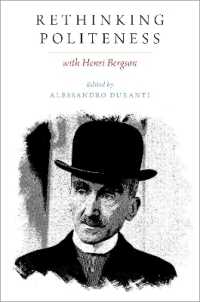- ホーム
- > 洋書
- > 英文書
- > History / World
Full Description
In 1906, a group of artists and intellectuals reinterpreted the tales of the Middle Eastern trickster Nasreddin to construct a progressive anti-colonial discourse with a strong emphasis on social, political and religious reform. Using folklore, visual art and satire, their periodical Moll? Nasreddin which had full-page lithographic cartoons in colour, reached tens of thousands of people across the Muslim world, from Iran and Turkey, to India and Egypt, impacting the thinking of a generation. The founder of the periodical was Jalil Mamedqolizadeh, an Azerbaijani educator and playwright. As a transnational and social democratic publication, Moll? Nasreddin saw itself as a mouthpiece for other persecuted Muslim populations and colonised peoples around the globe. This book looks at the milieu in which the periodical was born, the manner through which the journal recast the trickster trope for its audience, and the influence of European graphic artists on its cartoons and illustrations.
Contents
Introduction
Part I. The World of the Journal
Chapter 1. South Caucasus at the Turn of the Twentieth Century
Chapter 2. The Editorial Board
Chapter 3. Tiflis and Its Hybrid Artistic Community
Part II. Reimagining the Folk Trickster and Rethinking Gender Norms
Chapter 4. The Wise Fool and the Trickster Nasreddin
Chapter 5. Recreating the Trickster Tales and Tropes
Chapter 6. A Champion of Women's Rights
Part III. Dialogue with European Graphic Arts
Chapter 7. The Influence of Goya and Daumier
Chapter 8. A Conversation with Punch, Simplicissimus, and the World of Art
Epilogue








